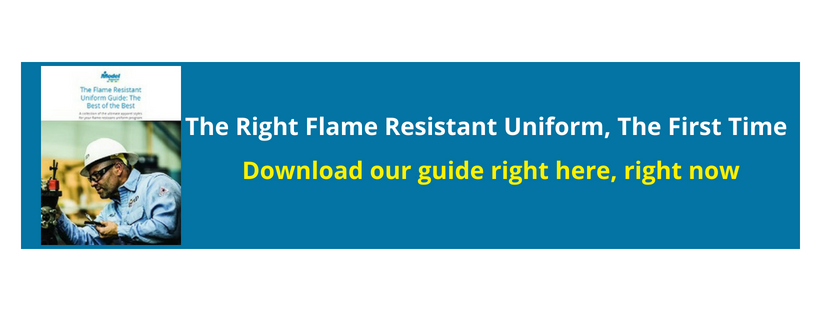Flame Resistant Clothing
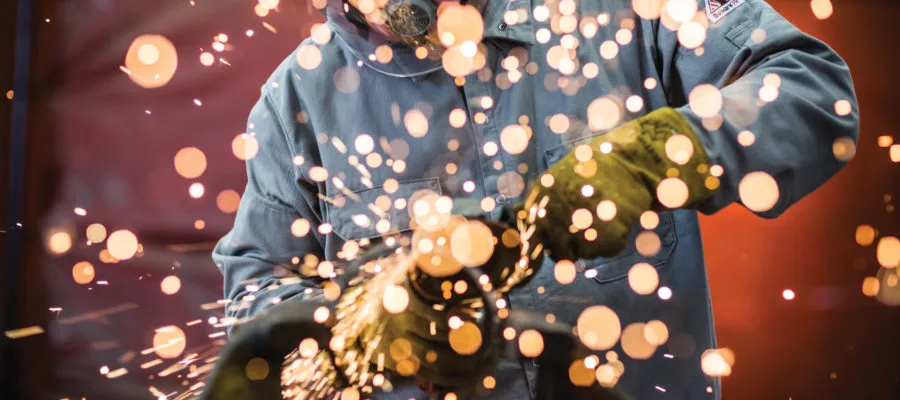
You start your day bright and early. Before you even step foot in your office, you do a walk through of the job site. You want to make sure the night shift was compliant with their uniform before they leave. Once in your office, you find a few tattered garments that need replaced and send in the replacement order forms. After crossing this off of your list, you check your inbox for the latest regulations that affect your team’s work environment.
Next, you gather the daylight shift for an hour long safety meeting. You’ll review any safety violations from the previous week and fill your team in on what to expect this week. They should know that you scheduled new subcontractors to be on site.
Once the meeting is over, you inspect your team as they head out for the day. It’s your job to make sure their uniforms are compliant.
Finally, after a few hours, you can start to tackle your “real” to-do list. You can’t believe you spend this much time fretting over your team’s uniform. Yet, it’s become a necessary evil for your company. As a leader in your organization, you know you need to stay on top of flame resistant clothing and the dangers they protect you from.
Flame resistant clothing has come a long way since its inception. Most experts agree that flame resistant clothing was “discovered” in 1821. This was when Joseph Louis Gay-Lussac, a decorated French chemist and physicist, discovered that combining ammonium phosphates with borax made textiles somewhat resistant to flames.
Fast forward to today, and the flame resistant fabrics market expects to be valued at 6.5 billion (USD) in the year 2024. That’s quite the jump in under 200 years.
And after all this time, we want to dive even deeper into the topic of flame resistant clothing. Deeper because it is dominating so many conversations in workplaces around the world. Companies are spending tons of resources to stay on top of the changing safety initiatives at work. As industry leaders learn more about the hazards they face, they turn to the safety products that meet those hazards head on.
Because of the importance of flame resistant clothing, it’s best to first understand the science behind the fabrics. Not knowing which fabrics will help keep you safe can have serious consequences. It’s important to know which fabrics provide the right level of protection for your environment.
How Does Flame Resistant Clothing Actually Work?
An easy place to start is to better understand the difference between flame resistant fibers and fabrics that inherently have that characteristic and ones that are chemically treated with such properties. What the heck are we even talking about? Let’s talk about it.
In layman’s terms, flame resistant fabrics are either inherently flame resistant or they’re treated to be flame resistant.
Said another way, the fibers that make up the fabric are manufactured to be flame resistant OR the fabric is treated to be flame resistant.
We know that can seem a bit confusing, but once you’re able to pick this up, you can begin to understand how important these types of clothing can be for your team.
To go deeper, check out our article written to make the distinction between the two clear. After reading our article, another resource to go to is this article. It’s from one of the better known personal protective equipment manufacturers, DuPont. They do a great job of explaining the differences between the two while making it easy to understand.
But beyond the cotton fabrics, there are others on the market built for these dangerous conditions. What kind of options are available so that no matter the environment, your team will be working with the best flame resistant garments known?
One of the least obvious places to look is rainwear. While rainwear is a standard set for any uniform in plenty of industries, you might not think of rainwear as being flame resistant.
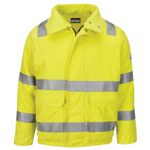
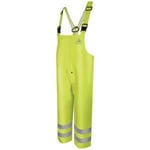
But it’s true.
Many people find it hard to believe that flame resistant fabric can be in rainwear. But the fabric is coated or laminated with the flame resistant properties. This coating is also designed to make the garment waterproof.
There are plenty of resources to source your flame resistant rainwear. But to get a general overview of this category, check out our article here. This should give you enough information to start your research into flame resistant rainwear and whether you need it.
While flame resistant rainwear might seem strange, there are other more familiar items that provide the same level of protection from flash fire hazards. Some of the more well known include FR work shirts and work pants, FR coveralls and FR parkas and bibs.
Depending on the environment you and your team work in, you might also need flame resistant head protection in the form of a knit cap or a balaclava.
These styles of flame resistant workwear are made from the more traditional Nomex and FR Cotton/Nylon blend fabrics. Again, flame resistant clothing is versatile enough to work with various fabric types while ensuring safety.
No matter what, determining the correct styles for your uniform program is imperative. First, you should consider performing a hazard assessment of your work environment. Doing this will help you determine the potential hazards your team faces while at work. To make this easy, see this hazard assessment checklist. This checklist will help you get in the habit of seeing possible problems so you can better prepare for them.
Only after completing your assessment should you look into what flame resistant clothing will best help to protect your team. Be sure to think about the comfort and happiness of your team when selecting their PPE (Personal Protective Equipment). You want them to engage in the uniform process by wearing their PPE every day. This should support your safety initiatives. See our article for insight into the top performing articles in flame resistant clothing.
Now that you have a better understanding of how flame resistant clothing works and what forms it comes in, think about the ways to protect your investment. When you’re spending more for flame resistant clothing, you want to make sure you’re getting the most value for your money.
Because flame resistant clothing is so expensive, the first thing to consider is how to wash and care for your garments. To treat flame resistant clothing the right way, start by reading the care label. The information on the label is there to protect your garments and your team.
Another way to protect your investment is to look at buying used flame resistant clothing. A misconception is that used clothing is in poor condition and should not be worn for safety reasons. But this isn’t true. Doing the right amount of research and understanding when flame resistant clothing should be removed from service can save you a lot of money.
At the end of the day, you need to have a true flame resistant uniform program in place. When you understand what you’re buying and how it fits into your company’s branding, you can control your costs appropriately. Establishing a uniform for your team, instead of allowing them to pick what they want, is huge. This allows you to control everything from inventory levels (if necessary) to the price of a single garment.
Flame Resistant Clothing Is All Around You
Take a moment to think about all the companies whose employees are in uniform every day. Here’s a short list of industries that some of our clients work in:
- Public utility
- Transportation & logistics
- Facilities Management
- Electrical energy & distribution
- Oil & Gas
- Residential services
But this is just the tip of the iceberg. Think of employees you’ve seen in uniform. They perform jobs in public safety, food services, retail, warehousing, automobile sales, professional services, education and countless others!
Of course, not every employee working in these industries / job sectors needs to wear flame resistant clothing. For the purposes of this discussion, let’s take a look at those industries that wear only flame resistant clothing as a part of their uniform.
As two of the more well known sectors of the energy industry, oil & gas exploration and electrical energy distribution are both primary targets of uniform companies. Uniform vendors know that there is a need to wear the right PPE while on the job site, so they work toward putting their name in front of the businesses in this industry.
But these methods have their limitations.
When managing a uniform program for flame resistant clothing, asking the right questions of your vendor can save potentially thousands of dollars and hours of your time. Some of the critical questions you need answered are:
“Do I need to buy a certain amount of inventory or can I order on an as needed basis?”
“What are the most durable products in the industry, regardless of their cost?”
“Can the process be streamlined with online ordering and returns?”
Purchasing flame resistant clothing for your uniform program can get expensive. You need to be aware of the best ways to manage the program so you aren’t wasting resources. These points are especially important to the Oil & Gas industry. Tight deadlines, onboarding new employees quickly and changing safety priorities make it important to know what you want from your uniform program.
Once you’ve established that flame resistant clothing is necessary for your uniform program, you can begin to gather the information that will educate you on the best ways to manage that program. This often becomes the responsibility of a safety manager or one person that understands the safety needs of the company.
In order for this person, and the company, to be successful concerning safety, the safety manager should be aware of the common problems uniform programs see in the oil and gas industry. These are often straightforward and self-explanatory, so little technical or advanced experience is required to manage the program.
Feeling confident in your ability to avoid these problems, now is the time to shop for the right flame resistant clothing. You already know that flame resistant clothing is more expensive than non-FR workwear, but how much money is too much for a set of uniforms for your team?
The short answer is, “more homework”.
While researching, you’ll find great products priced appropriately. You’ll also find the exact opposite. During the process, remember to consider the source of the flame resistant clothing. Some vendors will charge a premium because of special customization you need. Others will charge a premium for the clothing and provide incentives on shipping your orders to you.
Regardless of where you source your flame resistant clothing, this is the time to iron out the price-related details. Garments this expensive can put strain on a budget if you overlook the smallest details.
While talking about price, it would be a mistake not to mention one of the most expensive flame resistant clothing combinations on the market.
This “outfit” is also popular in the “other” well known industry of electrical energy distribution. It’s referred to as an outfit because it’s most often sold as three individual items in a package deal. Buying the kit as a package will get you the arc rated short coat, the arc rated bibs and the arc rated hood. Together, the three combine to make up the 40 cal/cm² arc suit.
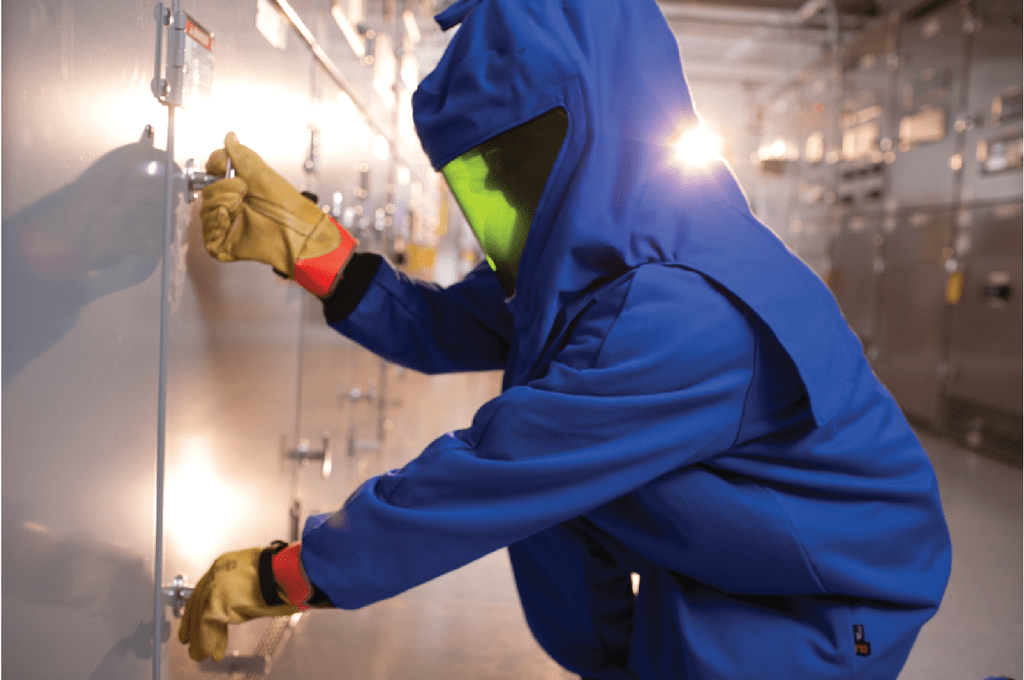
Designed to withstand a serious amount of energy, the suit works to prevent most 2nd degree burns. And while it might not be the most comfortable piece of equipment you ever wear, it’s not built to be comfortable. It’s made with safety as it’s number one priority. For more information on this life saving suit, see our review here. This will help you understand the importance of this type of flame resistant clothing.
Regulations Designed To Keep You Safe
While talking about all the environments where flame resistant clothing can be found, we briefly touched on NFPA 2112 and NFPA 70E. Reading about these regulations could be considered torture in some states. Sometimes, the technical jargon and legalese can be too much. But to understand it here, we’ll try to simplify it as best we can.
Simply put, NFPA 2112 is a standard put on flame resistant clothing for protection of industrial personnel against flash fire hazards. The standard takes care to address flame resistant clothing and it’s:
- Design
- Construction
- Evaluation
- Certification
Don’t take our word for it though. There are professionals and sources that are more knowledgeable than us, so please don’t look past them for information. The best way to learn more about NFPA 2112 is to download the standard here. Providing basic information will allow you the opportunity to download a digital version. Want the hard copy to keep on your desk? Those run $49.
To understand how NFPA 2112 affects the design and construction of flame resistant clothing, think about how a garment is made. How is the garment stitched together? Are there pockets or zippers? If so, what are the pocket linings and zippers made from? For example, using plastic zippers with non-FR synthetic tape is a recipe for disaster.
Sure, the garment will zip closed and help keep your employee warm. The trouble comes as soon as he experiences a flash fire. Once temperatures of 1,400 – 1,900 degrees reach the garment, the plastic teeth can melt together. Or the synthetic tape can melt into the teeth, making the zipper impossible to use. Would you want to be stuck in a garment that is on fire that can’t be taken off?
One of the first things a wearer learns about wearing these type of garments is to get out of the article of clothing. Yes, the garment is designed to ward off extensive burning once introduced to a flame source. But do you want to stick around and figure out how long the coverall you’re wearing is going to burn? We didn’t think so.
To be NFPA 2112 certified, flame resistant clothing must be evaluated on many tests, including but not limited to:
- Heat and Thermal Shrinkage
- Heat Transfer Performance
- Thermal Manikin Testing
- 100 Industrial Wash Durability of Flame Resistance
Industrial Safety and Hygiene News wrote an excellent article that goes a bit deeper into all these tests. They explain details such as how thermal shrinkage tests mandate that fabric experiences a maximum shrinkage of ten percent after being in a 500 degree Fahrenheit oven for 5 minutes. The manikin test uses a manikin covered in 122 heat sensors that is dressed in test clothing. The manikin is then exposed to flash fire conditions for a predetermined length of time. How the garment holds up determines whether it gets certified.
NFPA 70E is a standard that helps workplaces and employees avoid workplace injuries due to electric shock, electrocution and arc flash or arc blast hazards. For access to this standard in either downloadble or print format, use the link above.
One of the biggest differences between NFPA 2112 and NFPA 70E is that the 70E standard is considered a self-declaration standard. In short, manufacturers of flame resistant clothing can test garments themselves, declare themselves to be compliant with 70E and label their garments as such. While this might sound foolish or even illegal, there is a reason it’s handled this way.
NFPA 2112 is relevant to all components of flame resistant clothing, as mentioned before. Parts such as zippers and pocket linings must meet the requirements set by the standard in order to be compliant. The same is true for the finished garment under NFPA 2112.
The required testing under NFPA 70E is outlined by ASTM F1506 for materials or ASTM F1891 for rainwear. Both specifications are written around materials. There is even no requirement in the United States to test a finished garment for the electric arc hazard. But don’t worry, most manufacturers choose to test the garment as due diligence.
There are also no accreditation requirements for NFPA 70E. ISO 9001 is not required for manufacturers gain accreditation. Long story short, if a manufacturer is labeling a product as being NFPA 70E compliant, it’s their responsibility to maintain the data that proves the compliance.
Without all of this knowledge on flame resistant clothing, the health and safety of your team are in jeopardy. Like the manikin in the video below, flame resistant clothing is made to prevent catastrophes. Do your homework and find the right products for your team so you can send them home to their families at the end of the day.
.png?width=621&height=373&name=Model-Apparel%20Logo%20File%20from%20Ian%20(1.2).png)
.png)
